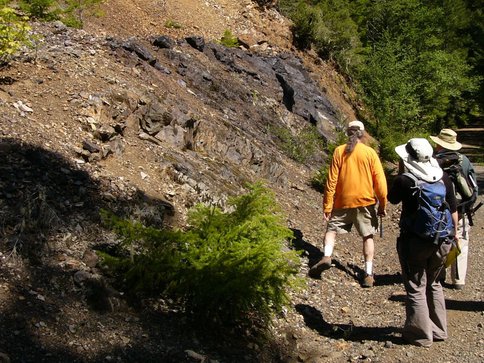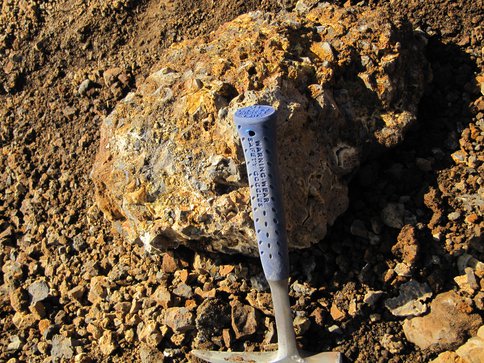2010 Annual Science Report
 NASA Ames Research Center
Reporting | SEP 2009 – AUG 2010
NASA Ames Research Center
Reporting | SEP 2009 – AUG 2010
Mineralogical Traces of Early Habitable Environments
Project Summary
The goal of our work is to discern the habitability (potential to support life) of ancient Martian environments, with an emphasis on understanding which environments could have supported more life than others. This information will help to guide the selection of sites on the Martian surface for future missions designed to seek direct evidence of life. Our approach has two main parts: 1. We will use the presence of specific minerals or groups of minerals – an analysis that can be performed robotically on Mars — to constrain the chemical and physical conditions of the ancient environments in which they formed. 2. We will work to understand how the ability of environments on Earth to support more or less biomass depends on these same physical and chemical conditions.
Project Progress
Efforts during this performance period have focused on (i) development and application of cell-scale bioenergetic models; (ii) characterization of mineralogy in samples collected from relict alteration deposits of the Josephine Ophiolite Complex and Spitzbergen, Norway; and (iii) parallel characterization of aqueous chemistry and biological diversity in samples collected from several actively serpentinizing systems.
(i) We have developed a cell-scale reaction transport model for determining single cell power generation for a defined metabolism in a medium of specified composition. The model determined diffusion in three dimensions (using a spherical cell), and includes biologically-realistic membrane transport properties. Model results are compared to estimates of cellular energy demand to estimate maximum growth rates and steady-state biomass density for specified conditions. We have applied the model for (a) characterization of energy balance in field sites with suitably-characterized conditions, and (b) estimation of changes in growth and biomass density potential for methanogenic metabolism across a range of parameter space relevant to serpentinizing systems. Results have been presented in talks at the 2009 Fall AGU meeting, AbSciCon 2010, the 13th International Society for Microbial Ecology Meeting, and the Extremophiles 2010 meeting.
Figure 1.. Team members Dawn Cardace and Dick Morris, with collaborator Greg Harper, examine deep-sea hot-spring deposits (dark rocks in foreground), beneath clastic sediments (lighter rocks, in background), during fieldwork in the Smith River drainage, CA/OR.
(ii) We conducted bulk mineralogical analyses on samples collected from the Josephine Ophiolite Complex (Figure 1) and Spitzbergen, Norway (Figures 2 and 3), as the basis for a mineralogical assessment of habitability, and to augment a library of reference spectra for instruments that will fly on MSL. Samples were analyzed by an analog of the CheMin instrument, and by a Mössbauer spectrometer analogous to that on the MER rovers. A portion of these analyses supported the detection of the Comanche carbonates on Mars, as reported by Co-I Morris in a 2010 publication in Science.
Figure 2.. Team member Dick Morris climbs to a sampling site on Sigurdsfjellet, during fieldwork in Spitzbergen, Norway. The Sigurdsfjellet volcanic site includes carbonate deposits similar to those found in ALH84001, and offers a natural setting in which to understand the genesis of such features.
Figure 3. Carbonate-bearing basalt from Sigurdfjellet volcano, Spitsbergen.. The sample is one of many carbonate-bearing Mars-analog samples collected during the field trip that are being analyzed in support of the MER (Moessbauer and APXS instruments), MRO-CRISM (visible and near-IR reflectance spectra), MSL (CheMin, SAM, and APXS instruments), and future Mars missions. Real-time analysis of the samples was done in the field with CheMin-like XRD instrument. Future carbon and other isotopic measurements are relevant to understanding the origin and evolution of life on the Earth and on Mars. Some Spitsbergen carbonates are very similar to the carbonate bearing rock recently discovered by the Spirit rover at Gusev Crater on Mars (Morris et al., 2010).
(iii) We conducted paired analyses of aqueous chemistry and presence or absence of functional genes associated with target metabolisms, in samples collected from a range of actively serpentinizing systems. Chemistry measurements were used to determine Gibbs energy availability and, in some cases, power availability (via the modeling described in (i)). Assessment of functional genes was used to screen for metabolisms predicted by energetic modeling to be favorable under in situ conditions. Results were presented at the 2009 Fall AGU meeting and AbSciCon 2010, and in a publication in Northeastern Naturalist.
Publications
-
Alperin, M. J., & Hoehler, T. M. (2009). Anaerobic methane oxidation by archaea/sulfate-reducing bacteria aggregates: 1. Thermodynamic and physical constraints. American Journal of Science, 309(10), 869–957. doi:10.2475/10.2009.01
-
Cardace, D., & Hoehler, T. M. (2009). Serpentinizing Fluids Craft Microbial Habitat. Northeastern Naturalist, 16(sp5), 272–284. doi:10.1656/045.016.0520
-
Fike, D. A., Finke, N., Zha, J., Blake, G., Hoehler, T. M., & Orphan, V. J. (2009). The effect of sulfate concentration on (sub)millimeter-scale sulfide δ34S in hypersaline cyanobacterial mats over the diurnal cycle. Geochimica et Cosmochimica Acta, 73(20), 6187–6204. doi:10.1016/j.gca.2009.07.006
-
Hoehler, T. M. (2010). Innumerable globes like this one?. Nature Geosci, 3(7), 447–447. doi:10.1038/ngeo900
-
Morris, R. V., Ruff, S. W., Gellert, R., Ming, D. W., Arvidson, R. E., Clark, B. C., … Squyres, S. W. (2010). Identification of Carbonate-Rich Outcrops on Mars by the Spirit Rover. Science, 329(5990), 421–424. doi:10.1126/science.1189667
-
Parenteau, M. N., & Cady, S. L. (2010). MICROBIAL BIOSIGNATURES IN IRON-MINERALIZED PHOTOTROPHIC MATS AT CHOCOLATE POTS HOT SPRINGS, YELLOWSTONE NATIONAL PARK, UNITED STATES. PALAIOS, 25(2), 97–111. doi:10.2110/palo.2008.p08-133r
-
Treiman, A. H., & Essene, E. J. (2011). Chemical composition of magnetite in Martian meteorite ALH 84001: Revised appraisal from thermochemistry of phases in Fe–Mg–C–O. Geochimica et Cosmochimica Acta, 75(18), 5324–5335. doi:10.1016/j.gca.2011.06.038
-
Vogel, M. B., Des Marais, D. J., Parenteau, M. N., Jahnke, L. L., Turk, K. A., & Kubo, M. D. Y. (2010). Biological influences on modern sulfates: Textures and composition of gypsum deposits from Guerrero Negro, Baja California Sur, Mexico. Sedimentary Geology, 223(3-4), 265–280. doi:10.1016/j.sedgeo.2009.11.013
-
Vogel, M. B., Des Marais, D. J., Turk, K. A., Parenteau, M. N., Jahnke, L. L., & Kubo, M. D. Y. (2009). The Role of Biofilms in the Sedimentology of Actively Forming Gypsum Deposits at Guerrero Negro, Mexico. Astrobiology, 9(9), 875–893. doi:10.1089/ast.2008.0325
- Anbar, A.D., Boyd, E.S., Buick, R., Claire, M., Des Marais, D., Domagal-Goldman, S., Eigenbrode, J., Erwin, D., Freeman, K., Hazen, R., Johnson, C., Lyons, T., Meadows, V., Ohmoto, H., Ono, S., Peters, J.W., Shapiro, B., Summons, R. & Walter, M. (2010). An Archean biosphere initiative [abstract 5593]. Astrobiology Science Conference 2010.
- Cardace, D. & Hoehler, T.M. (2010). Extremophiles in serpentinizing systems: Implications for life on the Early Earth and Other Planets. In: Harrison, S. & Rajakaruna, N. (Eds.). Serpentine: A Model for Evolution and Ecology. University of California Press.
- Cardace, D. & Hoehler, T.M. (2010). Subsurface Investigation of the Coast Range Ophiolite, Northern California: Field Campaign Findings [abstract]. Abstracts of the NASA Astrobiology Science Conference.
- Des Marais, D.J. (2009). Hints of habitable environments on Mars challenge our studies of Mars-Analog sites on Earth [Abstract]. Geochimica et Cosmochimica Acta, 73(Suppl. 1): A285.
- Des Marais, D.J. (2010). Marine hypersaline Microcoleus-dominated cyanobacterial mats in the saltern at Guerrero Negro, Baja California Sur, Mexico. In: Seckbach, J. (Eds.). Microbial Mats, Cellular Origins, Life in Extreme Habitats and Astrobiology (COLE) Series. Springer.
- Des Marais, D.J. (2010). Potentially habitable ancient environments in Gusev crater, Mars [Abstract]. Goldschmidt 2010, abstracts, Knoxville, TN. None, 40: 76.
- Des Marais, D.J. (2010). The proposed 2018 MAX-C rover: Exploring for signs of life and caching samples for potential return [Abstract 5532]. Astrobiology Science Conference 2010.
- Dueck, S.L., Zachary, S., Michael, D., Parenteau, M., Kubo, M., Jahnke, L., Scalice, D. & Des Marais, D.J. (2010). Astrobiology student intern program at Lassen Volcanic National Park [Abstract 5434]. Astrobiology Science Conference.
- Hoehler, T.M. (2009). Life at the common denominator: Mechanistic and quantitative biology for the earth and space sciences [ABSTRACT]. EOS Transactions AGU, 90(52): P32B-01.
- Hoehler, T.M., Alperin, M.J., McCollom, T.M. & Rogers, K.L. (2010). An energy balance model for the habitability of serpentinizing systems [ABSTRACT]. Abstracts of the 2010 Astrobiology Science Conference.
- Hoehler, T.M., Alperin, M.J., McCollom, T.M. & Rogers, K.L. (2010). Modeling energy flow at the cellular level [ABSTRACT]. Abstracts of the 13th International Society for Microbial Ecology Meeting.
- Hoehler, T.M., Gunsalus, R.P. & McInerney, M.J. (2010). Environmental constraints that limit methanogenesis. In: Timmis, K.N. (Eds.). Handbook of hydrocarbon and lipid microbiology. Springer-Verlag.
- Jahnke, L.L., Parenteau, M.N. & Farmer, J.D. (2009). Microbial community biosignatures in silica-depositing thermal springs: Grand Prismatic Spring, Yellowstone National Park [Abstract]. Geological Society of America 2009 Annual Meeting. None, 41(7): 44.
- Jahnke, L.L., Parenteau, M.N. & Farmer, J.D. (2010). Microbial biosignatures in a streamer mat community from silica-depositing Grand Prismatic Spring, Yellowstone National Park [Abstract 5631]. Astrobiology Science Conference.
- McCollom, T.M., Bach, W. & Hoehler, T.M. (2010). Constraints on the generation of hydrogen for microbial metabolism during serpentinization [ABSTRACT]. Abstracts of the 2010 Astrobiology Science Conference.
- Mumma, M., Des Marais, D.J., Baross, J., Sherwood Lollar, B., Hand, K., Villanueva, G., House, C., Ferry, G., McCollom, T., Sotin, C., Goldman, S., Vance, S. & Painter, T. (2010). The astrobiology of Mars: Methane and other candidate biomarker gases, and related interdisciplinary studies on Earth and Mars [abstract 5590]. Astrobiology Science Conference 2010.
- Parenteau, M.N., Farmer, J.D., Jahnke, L.L. & Cady, S.L. (2010). Terrestrial iron hot springs as analogs for ancient Martian hydrothermal systems [Abstract 5636]. Astrobiology Science Conference.
- Parenteau, M.N., Jahnke, L.L., Green, S.J., Boomer, S.M. & Pierson, B.K. (2010). Marine Chloroflexus-like organisms synthesize mid-chain branched monomethylalkanes [Abstract 5643]. Astrobiology Science Conference.
- Schwenzer, S.P., Abramov, O., Allen, C.C., Clifford, S., Filiberto, J., Kring, D.A., Lasue, J., McGovern, P.J., Newsom, H.E., Treiman, A.H., Vaniman, D.T., Wiens, R.C. & Wittmann, A. (2010). Exploring martian impact craters: Why they are important for the search for life. [abstract]. Lunar Planet. Sci. 41st. Abstr. #1589.
- Treiman, A.H. & Essene, E.J. (2010). Metamorphic origin of sub-micron magnetite crystals in ALH 84001: Re-evaluation of equilibria, compositions, and experiments. [abstract]. Abstracts of the 2010 Astrobiology Science Conference. Abstr. #5150.
- Treiman, A.H. & Essene, E.J. (2010). Metamorphic origin of sub-micron magnetite crystals in ALH 84001: Re-evaluation of equilibria, compositions, and experiments. [abstract]. Lunar Planet. Sci. 41st. Abstr. #1159.
- Treiman, A.H., Robinson, K.L., Blake, D.F. & Bish, D. (2010). Mineralogy determinations by CheMin XRD, tested on ultramafic rocks (mantle xenoliths). [abstract]. Abstracts of the 2010 Astrobiology Science Conference. Abstr. #5150.
- Vogel, M.B., Des Marais, D.J. & Jahnke, L.L. (2010). Mineralogy and organic preservation in acid sulfate fumaroles and thermal features: analogs for Mars early aqueous history [abstract 5355]. Astrobiology Science Conference 2010.
-
PROJECT INVESTIGATORS:
-
PROJECT MEMBERS:
David Blake
Co-Investigator
Linda Jahnke
Co-Investigator
Richard Morris
Co-Investigator
Victoria Orphan
Co-Investigator
Allan Treiman
Co-Investigator
Bo Barker Jørgensen
Collaborator
Sherry Cady
Collaborator
Kenneth Stedman
Collaborator
Roger Summons
Collaborator
Dawn Cardace
Postdoc
Niki Parenteau
Postdoc
Marilyn Vogel
Postdoc
Mike Kubo
Research Staff
-
RELATED OBJECTIVES:
Objective 2.1
Mars exploration.



